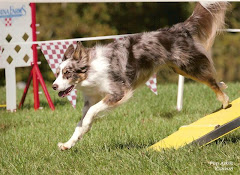I know. No one wants to hear about cancer. But this topic, along with all the diagnostics and treatments can be very overwhelming, especially when you are faced with an emotional decision of what to do when your pet is diagnosed with something undesirable. So with the idea that knowledge is power I plan to do a series of posts of cancer to hopefully clear up a lot of confusion and questions people may have. Although hopefully no one ever needs to use most of this information!
What is cancer?
Cancer, or neoplasia, is any growth (collection of cells) that have mutated in such a way that they multiply out of control. These growths can be benign or malignant. Benign masses are those that don't spread (metastasize), recur after removal, and generally don't invade or destroy surrounding tissues. Malignant neoplasms are the bad ones-these can spread to other organs, grow rapidly and destroy normal tissues.
So what causes cancer? This is the hardest to answer and at the same time the easiest! Mutations cause cancer. Something in cell division goes wrong and the genes that control further division are no longer working. There are many checks and balances in cell division that repair damaged DNA so that a single mutation is no big deal. It usually requires about 3 mutations before things go haywire. But what causes the mutations? That's the hard one. It's likely a combination of genetics, environment, age, and luck. But no one really knows for sure.
Diagnosing Cancer
Diagnosis of cancer can vary widely. One of the easiest tests is a Fine Needle Aspirate or Needle Biopsy. This is a quick test that can be performed with little discomfort to the pet. Essentially some cells from the mass are sucked into a syringe and sprayed on a slide which is then stained and evaluated. Sometimes a definitive diagnosis can be reached with just this test. Sometimes only enough information is gained to decide more testing needs to be done or cancer can be ruled out completely. Some doctors will look at the slide themselves and some will send to a pathologist. I will usually look at it and if I'm not sure what it is or I need a second opinion I will send it out.
Surgical biopsies are probably the most common route of making a diagnosis. Depending on the size and location the biopsy might be incisional (taking only a piece) or excisional (taking the whole mass). If a benign mass is removed in it's entirety an excisional biopsy may be curative as well. Biopsies differ from cytologies (needle aspirates) because the pathologist can look at the tissue structure, evaluate the margins (to see if it was all removed) and grade the tumor on how aggressive it is. These must be sent to a pathologist where this tissue is sliced into thin pieces, stained and evaluated under the microscope.
For internal tumors other diagnostic procedures are used. Radiographs or x-rays are usually the first screening test for suspected internal masses. Radiology is limited in that it is two-dimensional and only shows shades of gray and shapes or outlines of organs and masses. Ultrasound can help determine more about a mass such as where is comes from and what the structure is like (solid, cystic, etc). Ultrasound can also be used to for guided needle biopsies of internal masses (so you know where you are sticking!).
Sometimes exploratory surgery is warranted to get a diagnosis or remove the tumor so it can be sent for biopsy.
For some masses more advanced imaging such at CT or MRI are needed. These can help determine the extent of the tumor and evaluate tumors in places that are not easily accessible such at the brain, nasal passages or spinal cord. This information is often used in determining what treatment options are available and in planning radiation therapy.
Treating Cancer
Treatment options are widely varied but the three most common are surgery, radiation, and chemotherapy or a combination of these. As mentioned before the goal of surgery can be two-fold: get a diagnosis and cure if possible. When removing a mass we try to get "clean" margins. This means getting all the tumor cells so we try to plan our incision in such a way as to get some extra normal tissue when we remove the mass. We are lucky in that dogs and cats have a lot of extra skin so this is quite frequently possible. Sometimes though when the mass is in more difficult areas such as the tail or legs we are not able to get the entire mass. Amputation or adjunctive chemo or radiation may be needed in some of these cases. Removal of internal masses varies depending on what organ the mass originates from.
Chemotherapy is commonly used in several types of neoplasia. People frequently ask if chemo in dogs is like chemo in people. And the answer is yes, and no. In dogs we tend to not be as aggressive with chemo as we are in people. Part of the reason for this is that dogs don't have a lifespan of 80 years. So if we can give a geriatric dog 12-18 months of quality life that's considered a good success, by then the dog may have reached the end of his life anyway. In a person we are often trying to get 10-30 years or more of quality life so treatments are more aggressive. Most of the time chemotherapy in veterinary medicine is not going to get you a cure, just time.
But, that being said the biology of chemo is the same in animals and humans. Chemo targets rapidly dividing cells (ie cancer cells). Other rapidly dividing cells include bone marrow, the GI tract and hair follicles so these systems are subject to side effects. Red and white blood cells and platelets are all made in the bone marrow-this is why a complete blood count (CBC) is monitored during chemotherapy. If the blood counts get too low it makes it easy for the patient to become ill, and hard for them to fight infection if they become ill. The destruction of the GI lining is why chemo patients have nausea and vomiting but we have excellent drugs to overcome these issues. Now, about the hair. Generally speaking dogs don't lose hair (not all their hair anyway) on chemo. Remember, only about 1/3 of the hairs are growing at any time-the rest are already falling out or dormant. So, mostly you won't notice any abnormal hair loss during chemo. The exception is continuously growing breeds such as poodles, these dogs might lose a lot of hair.
Cost of chemo can vary widely-some are very cheap, some are very expensive. And many protocols require multiple drugs. Some clinics don't perform chemo treatments and the time and expense of traveling to the referral facility must be factored in. In addition to the cost of the drugs there is also the cost of the required monitoring bloodwork which will vary with the protocol and drugs used. And although most drugs are administered via injections, some are given orally at home.
Radiation therapy is frequently used when complete excision is not obtained or where surgery is not an option and/or the type of tumor is not chemo responsive. A benefit to radiation is that the beam is targeted at the affected area and there are not systemic effects as there are with chemo. However any structure near the beam can be damaged. For example if the radiation site is near the eye the tear ducts or lacrimal gland can be damaged. Radiation in the oral cavity can cause ulcers or tongue sores. Hair will frequently not regrow in areas of radiation.
Traditional radiation therapy involves treatment up to 5 days a week for about 4 weeks. Radiation must be done at a special facility and is expensive. If you don't live near the facility it can mean leaving your pet for days or weeks at a time for treatment. Also, because pets don't sit still radiation require anesthesia for every treatment. Not all pets are candidates for this. So, while this can be a very useful and often painless treatment option there are several limiting factors.
Other treatment options or variations of these treatment options exist but are outside the scope of this post and are best discussed with an oncologist. The best treatment for your pet is the one that meets your goals while taking into consideration your pet's comfort level and condition as well as your financial situation and lifestyle.
Staging
Staging of the cancer is one of the important steps in determining both prognosis and treatment options. Staging means determining how much, if at all, the disease has spread. Although cancer cells can in theory spread (metastasize) to anywhere, the two most common places are the local lymph nodes and the lungs. Lymph is a fluid that bathes most tissues of the body and essentially acts as a "cleaner" draining infections, dead cells and other "trash" from the body. Cancer cells travel through the lymph vessels and then set up shop in the closest lymph node to the mass. There are nodes on the outside of the body that you can feel if they become enlarged and these can be checked via needle aspirate or biopsy for tumor cells. Internal lymph nodes are harder to check. If they are grossly enlarged they might show up on radiographs or if surgery is being performed they can be checked at that time. Cancer spreads to the lungs because all blood circulates through them so any tumor cells traveling in the blood stream will eventually end up there and can get stuck in the tiny capillaries and start proliferating. Therefore, thoracic radiographs are another tool used in staging. Abdominal films are also sometimes done depending on the type of tumor, location, and expected behavior. One additional note on checking for metastatic disease-while radiographs clear of metastatic disease is obviously good, it is not a guarantee that there is no spread of disease. A metastatic lesion must reach a certain size (a certain number of cells) before it shows up on the x-ray. The same is true of a lymph node-it can easily have some irregular cells in it without being enlarged. This is why chemo may be frequently recommended in cases even where the met check is clean.
So that was pretty long but I think it gives a start in the understanding of cancer. Next we will discuss individual diseases.
Cattle Call
6 days ago


.jpg)
.jpg)



.jpg)



7 comments:
Hard choices.
Nicki,
Thank you for writing this. Having lost several animals to cancer it is good to have as much information as possible and to understand it. It also can help us all keep an eye on our animals for signs of cancer.
Robin
Thanks for this very informative post! Far too many of our canine friends in the agility world have lost the battle to cancer in the last year. :o( It is a horrible disease.
I look forward to the following posts in this series.
I read a lot of popular science writing as part of my job (I write middle school science curriculum), and I just want to say that this is phenomenally clearly written. I feel instantly more knowledgeable about something *so* important, even to me as a person, not just a pet owner. So, I thank you, and hope that you will continue to bring your concision and clarity to bear on other topics as well.
Hi Nicki,
Doug (above) is my husband. I forwarded this post to him since he's teaching anatomy to his students right now and I thought your explanation was so clear and free of unnecessary jargon. Great job!
Carrie
Thanks Carrie (and Doug)-was wondering who
that might be!
wow, one of those things that is hard to really find out about so I am so glad you have tackled giving us some idea of what the deal is-for lack of a more elegant way of saying that, LOL, thanks!
Post a Comment